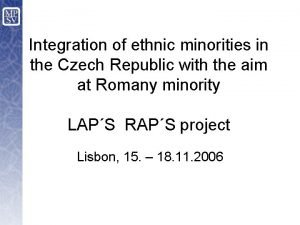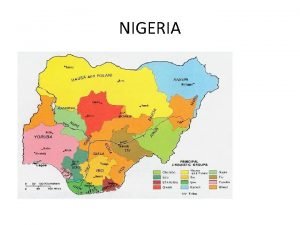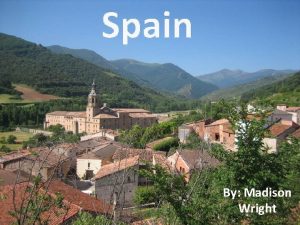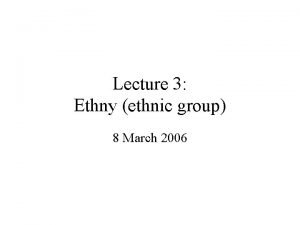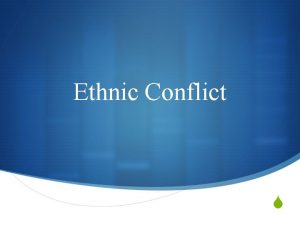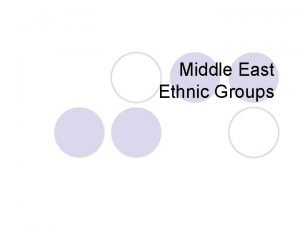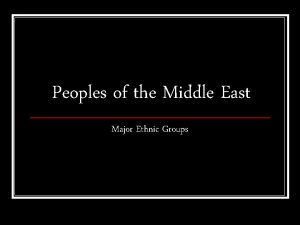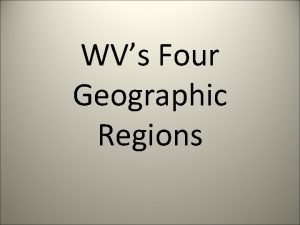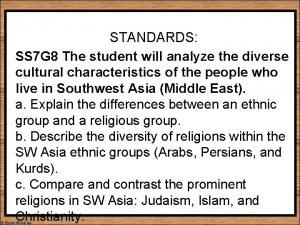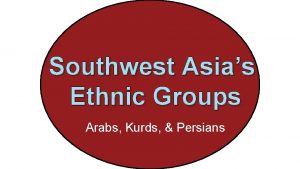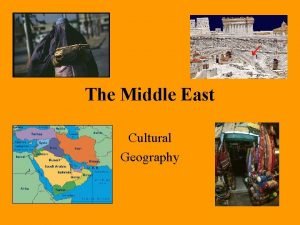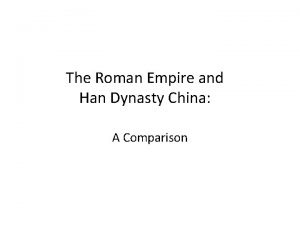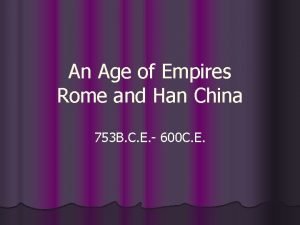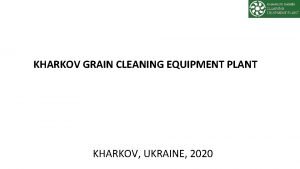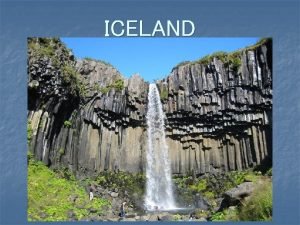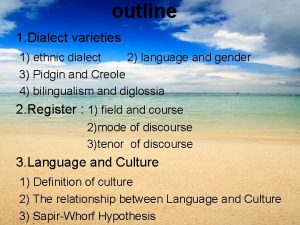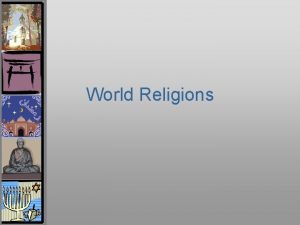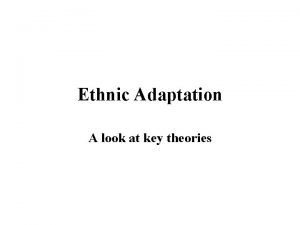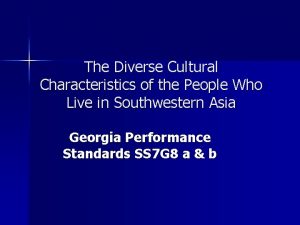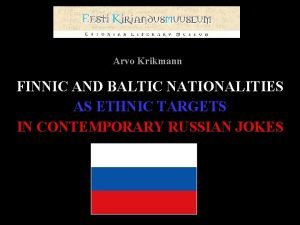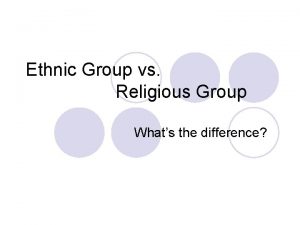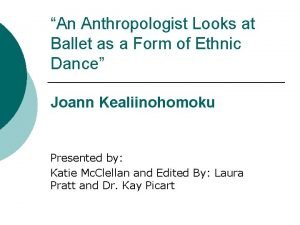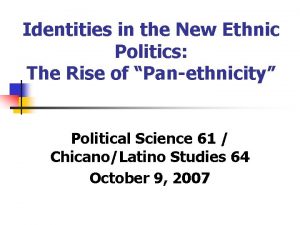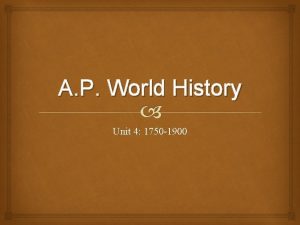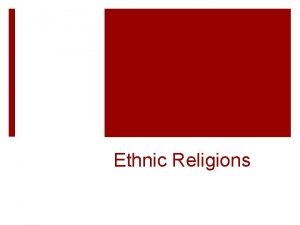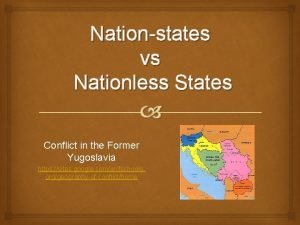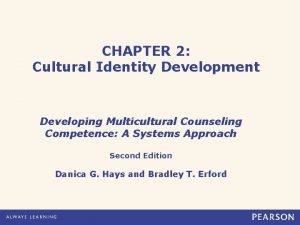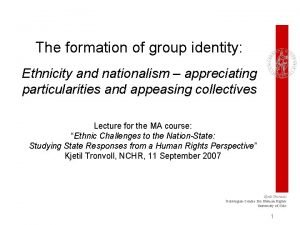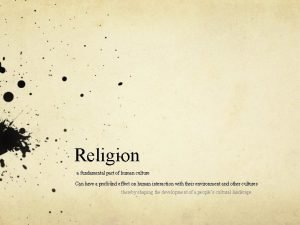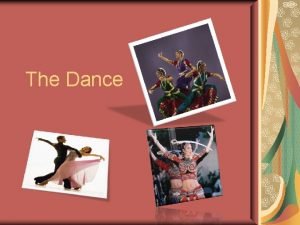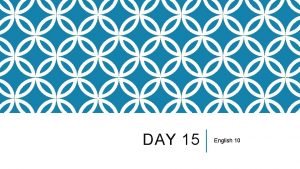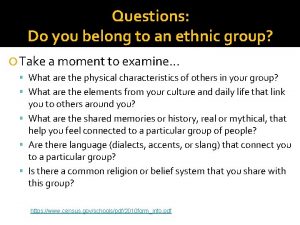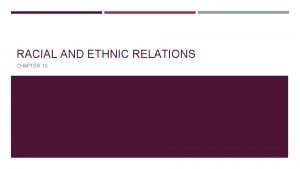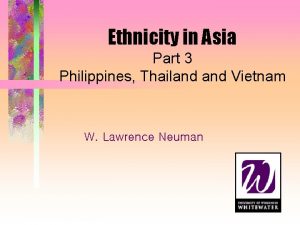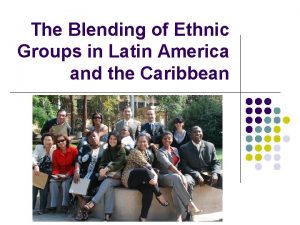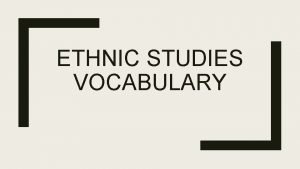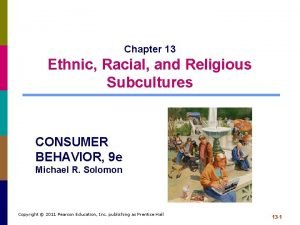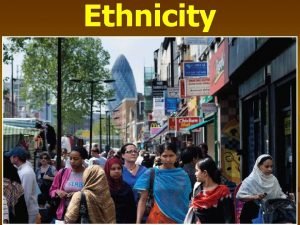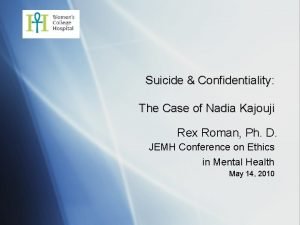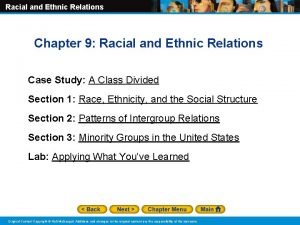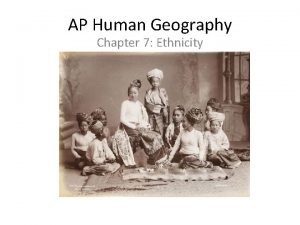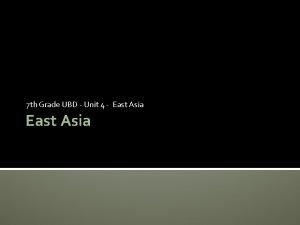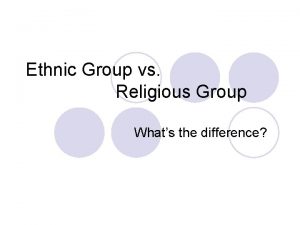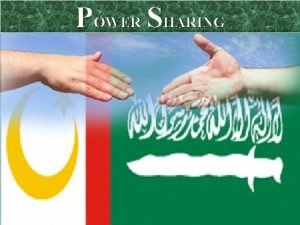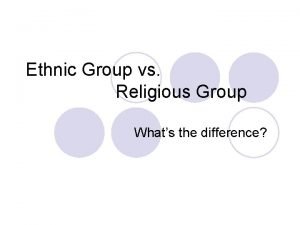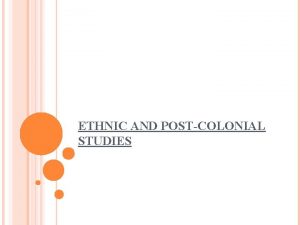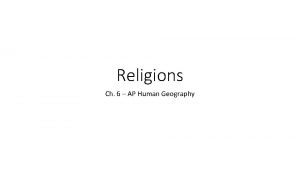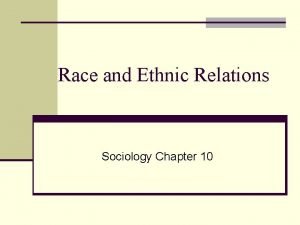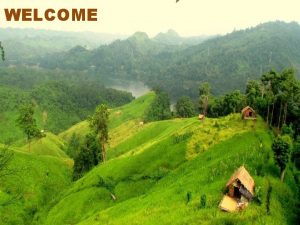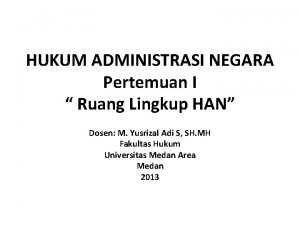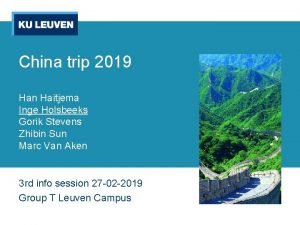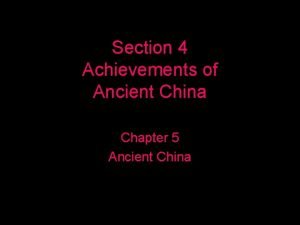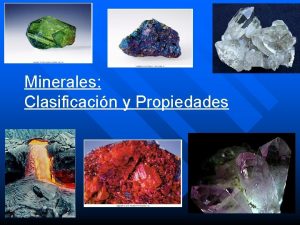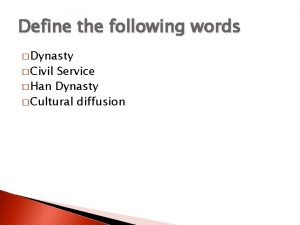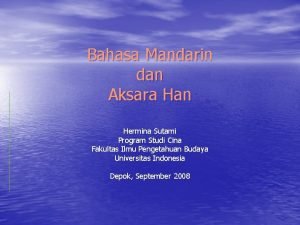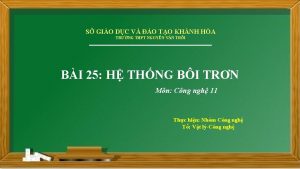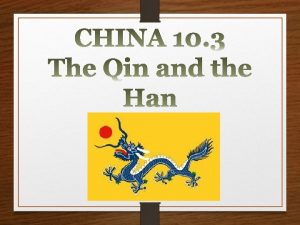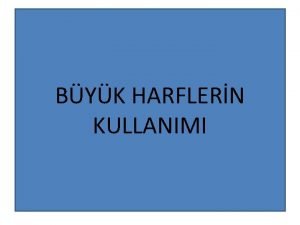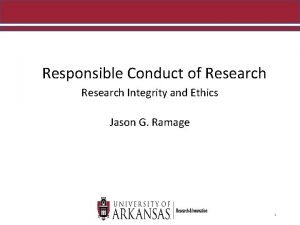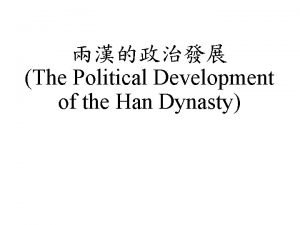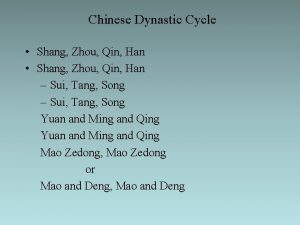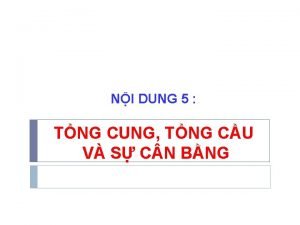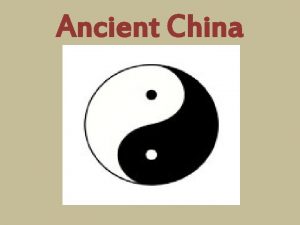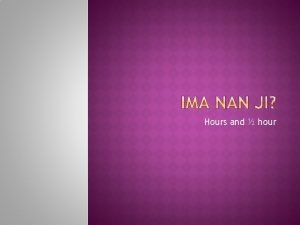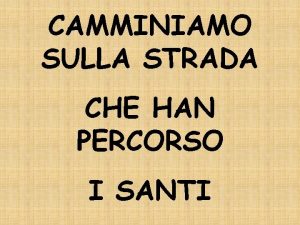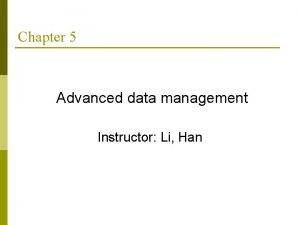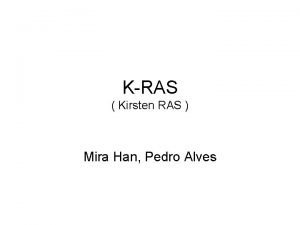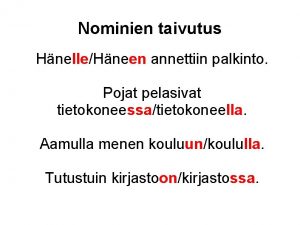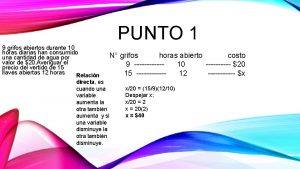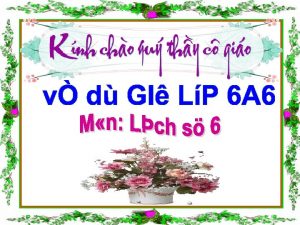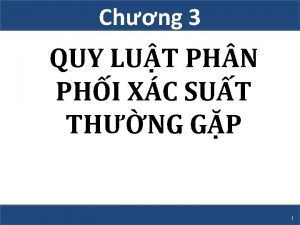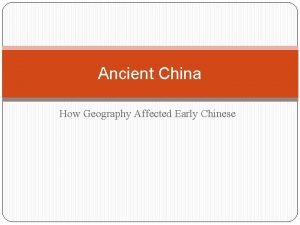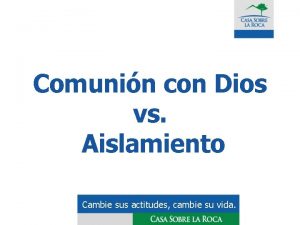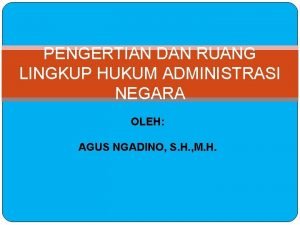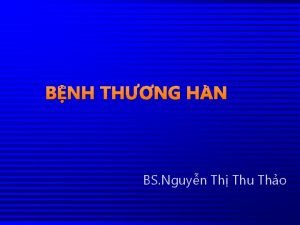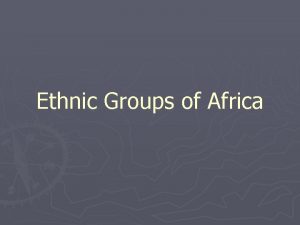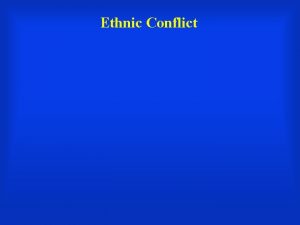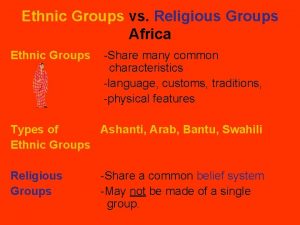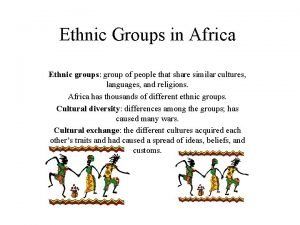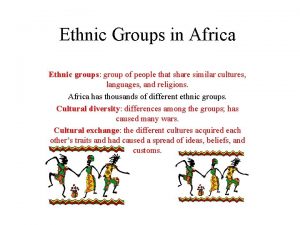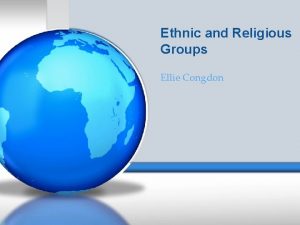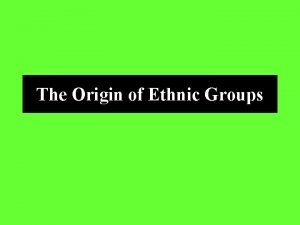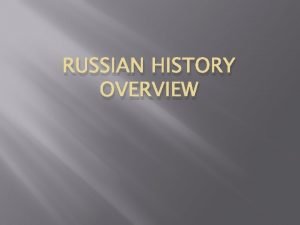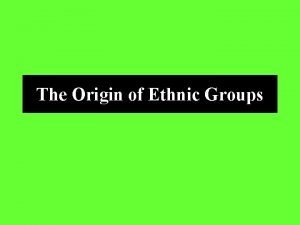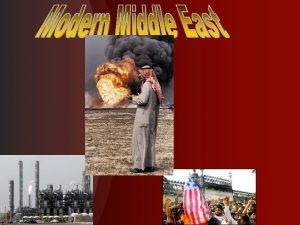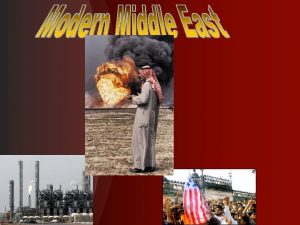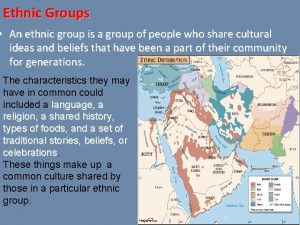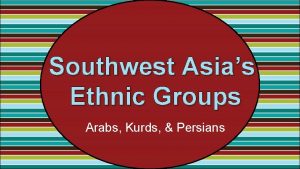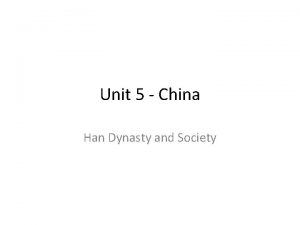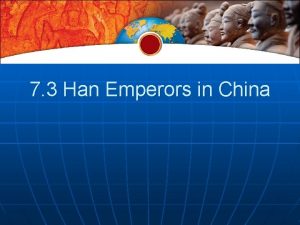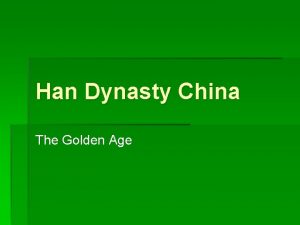China Today Chinese Ethnic Groups Han Chinese 91

























































































































- Slides: 121


China Today

Chinese Ethnic Groups Han Chinese - 91%

Other 55 ethnic groups- 9% Manchu Tibetan Miao Mongols Hui Yao

Geography and Early China The Big Idea Chinese civilization began with the Shang dynasty along the Huang He. Main Ideas • China’s physical geography made farming possible but travel and communication difficult. • Civilization began in China along the Huang He an Chang Jiang rivers. • China’s first dynasties helped Chinese society develop and made many other achievements.

Physical Geography Varied Landscape • China covers an area of almost 4 million square miles. • The Gobi desert lies in the north. • Low-lying plains in the east make up one of the world’s largest farming areas. • Mountain ranges lie in the west, including the Plateau of Tibet and the Qinling Shandi. There was limited contact between people in the east and west. • The weather and temperature vary from cold and dry to wet and humid, and monsoons can bring up to 250 inches of rain each year.

The 4 Old-World River Valley Cultures


“Peking Man” (750, 000 – 500, 000 BCE) Sinanthropus pekinesis

Two Rivers of China Huang He Chang Jiang • Also called the Yellow River • The longest river in Asia; also called the Yangzi River • Nearly 3, 000 miles long across northern China • Often floods, and has been referred to as “China’s sorrow” because of the destruction • Flows across central China from Tibet to the Pacific Ocean

Yellow River Civilization

Civilization Begins Farming • Frequent flooding made the land fertile around the Chang Jiang and Huang. He (Yellow)rivers. • Along with farming, the Chinese people hunted, fished, a domesticated animals. Early Settlements • Some small villages along the rivers grew into larger cities. • Separate cultures developed in the north and the south. Over time people learned to dig wells and use potter’s wheels. • Findings at burial sites suggest that the ancient Chinese believed in an afterlife and had a complex social order.

Neolithic Pottery 3000 BCE to 2000 BCE

Pan-Gu: Mythical Creator of the Universe

“Chung Kuo” (The “Middle Kingdom”)

Ancient China : History. Highlights

Ancient China Begins a Series of Dynasties China was made up of many kingdoms, which had many different dynasties. The three major Ancient dynasties were the Zhou, Qin, and Han dynasties.

Start here Emperor is defeated !! Rebel bands find strong leader who unites them. Attack the emperor. Poor loose respect for govt. They join rebels & attack landlords. A new dynasty comes to power. The emperor reforms the govt. & makes it more efficient. The Dynastic Cycle Droughts, floods, famines occur. Lives of common people improved; taxes reduced; farming encouraged. Problems begin (extensive wars, invasions, etc. ) Taxes increase; men forced to work for army. Farming neglected. Govt. increases spending; corruption.


Xia Dynasty Legendary Dynasty--No evidence found until 1959.

Xia Dynasty • The Xia dynasty might have been founded around 2200 BC, by Yu the Great. • Tales say that Yu dug channels to drain floodwaters and created the major waterways of North China. • Archaeologists have no firm evidence that tales about the Xia dynasty are true.

Yu, the Great – Founder of the Hsia (Xia)

Emperor Fuxi § Mythical Hsia ruler. § Taught the Chinese how to read and write, according to legend.

Hsia Plaque, 1700 BCE


Bronze Age Empires

Shang: 1523 -1028 BCE

The Shang Dynasty Fooled You! No Music!

Shang Dynasty • Established by 1500 BC, the Shang was the first dynasty that there is clear evidence to support. • The Shang reorganized the social order in China: the top ranking was the royals, then nobles, warriors, artisans, farmers, and slaves. • Most citizens lived within the city walls. • Many cultural advances were made, including China’s first writing system, complex tools, metal pots, and ornaments.

1500 -950 B. C. : Earliest examples of written Chinese

Sample of Chinese Writing Sample text in Chinese Translation All human beings are born free and equal in dignity and rights. They are endowed with reason and conscience and should act towards one another in a spirit of brotherhood. (Article 1 of the Universal Declaration of Human Rights)

Oracle Bones

Oracle Bones Calendar

The Evolution of Chinese Writing during the Shang Pictographs Semantic-Phonetics

Axe Scepter – 1100 BCE jade Ceremonial Dagger – 1028 BCE

Sha ng Urn

Shang Bronzes

Ritual Wine Vessel – bronze, 13 c BCE


The Zhou Dynasty

Western Zhou: 771 BCE 1027 -

Eastern Zhou: BCE 771 -256

The Zhou Dynasty and New Ideas The Big Idea Confucius and other philosophers taught ways to deal with social and political problems in ancient China. Main Ideas • The Zhou dynasty expanded China but then declined. • Confucius offered ideas to bring order to Chinese society. • Daoism and Legalism also gained followers.

The Zhou Political System • The Zhou people worked with other tribes to overthrow the Shang dynasty in the 1100 s BC. • Zhou leaders believed that their rulers were mandated by heaven, and that heaven would find another leader when necessary. • A new political order was established: the king granted plots of land to lords, who in turn provided soldiers and paid taxes to the king. Poor farmers were granted land as well, and remained under the rule of the lords. • The lords helped Zhou rulers keep control of the dynasty.

Decline of the Zhou Dynasty • As the lords’ power grew, they became uninterested in serving Zhou rulers. Many refused to fight against Zhou enemies. • In 771 BC, the Zhou suffered a loss to invaders. The dynasty survived, but morale weakened, and the Zhou began to fight among themselves. • The Warring States Period marked power struggles between the ruling-class families. • Problems within the government paralleled problems within large family systems, which were breaking down. Bonds of loyalty weakened within even small families, and disorder fell upon China.

Confucianism Moral Values Disgusted with the rude and insensitive nature of the people around him, Confucius pushed for a return to ethics, or moral values. The Analects This code of ethics was passed down and written in a book. These stories focused on morality, family, society, and government. Leading by Example One of the major ideas Confucius put forth for the success of both family and government was leading by example. Confucius believed that when people behaved well and acted morally, they were carrying out what heaven expected of them.

Confucius Confucianism • Emperor known as “Son of Heaven” • Said to rule with the “Mandate of Heaven” • Class of political administrators to assist Emperor • Trained in ritual and proper conduct

Two Schools of Thought Daoism Legalism • Daoism comes from Dao, meaning “the way. ” • Legalism is the political philosophy that people need to be controlled. • Daoists believed that people should avoid interfering with nature or each other. • Laozi wrote The Way and Its Power, a book teaching that power and wealth are unnecessary. • It is unconcerned with religion or individual thought, and prepared always for war. • Legalists put their ideas into practice throughout China.

Lao Tzu (Old Master) ØCreated Taoism ØYin and Yang Ø“Stop thinking and end your problems. ”

• Taoism is a sort of “nature mysticism” • Taoists express joy and amazement over nature • They seek to identify with this nature, which they call “Tao” • In Taoism, the tao refers to the law of the universe • To Taoists, the tao brings all things into existence and governs them.

Yin and Yang

Ritual Food Vessel, bronze 11 c BCE (Western Zhou)

Pendant of a Dancer jade 3 c BCE (Eastern Zhou)

Ritual Wine Vessel – 4 c bronze, silver, gold, copper

Zhou Coins bronze

“T’ien Ming” The Mandate of Heaven 1. The leader must lead by ability and virtue. 2. The dynasty's leadership must be justified by succeeding generations. 3. The mandate could be revoked by negligence and abuse; the will of the people was important.


The Qin Dynasty

The Qin Dynasty The Big Idea The Qin dynasty unified China with a strong government and a system of standardization. Main Ideas • The first Qin emperor created a strong but strict government. • A unified China was created through Qin policies and achievements.

“Huangdi” – § The “Yellow Emperor. ” § Legend has it that he ruled for over 100 years. § Associated with the invention of wheeled vehicles, ships, armor, pottery, and silk-making.

Shi Huangdi • The Legalist Qin king Yin Zheng took the throne in 221 BC and gave himself the title Shi Huangdi, which means “first emperor. ” • He burned all books and writings that dealt with any practice other than Legalism. • He created a strict government with harsh punishments. • He used his armies to expand the empire and ensured that there would be no more revolts in the new territory. • He claimed all power and took land away from the lords. Commoners were forced to work on government building projects. • China was divided into districts with their own governors.

Unified China Politics Culture Finance • Shi Huangdi took complete control of the land the people. • Shi Huangdi set up a uniform system of law. • Gold and copper coins were standardized. • Rules and punishment, writing styles, and money were consistent across China. • Uniform weights and measures help standardize trade and other legal issues. • There was a strict chain of command. • Taxes and building projects were introduced.

Qin Achievements Building Projects • Massive government building projects gave jobs to many poor workers. • New roads were built and maintained to provide easy access to and from these buildings. Water Systems • Canals were built to connect rivers and keep trade fast and efficient. • Irrigation systems that are still in use today watered the fields and made more land good for farming.

The Great Wall Of China • The Great Wall was built to protect the country from invasion • The Great Wall linked previously built walls across China’s northern frontier. • The building of the wall required years of labor from hundreds of thousands of laborers.

The Fall of the Qin: The Oppressed Rise Up • Many scholars, peasants, and nobles grew resentful of Shi Huangdi’s harsh policies and complete control. • Upon the death of Shi Huangdi, the country began to unravel. • Rebel groups fought among themselves, and eventually the Qin capital was burned to the ground. • With no authority present, the country fell into civil war.

Emperor Qin Shi Huangdi




The Terracota Warriors


The Han Dynasty

The Han Dynasty The Big Idea The Han dynasty created a new form of government that valued family, art, and learning. Main Ideas • Han dynasty government was based on the ideas of Confucius. • Family life was supported and strengthened in Han China. • The Han made many achievements in art, literature, and learning.

The Rise of a New Dynasty • Liu Bang, a peasant fighting in a rebel army, became emperor due to the Chinese belief in the mandate of heaven. • He was the first emperor of the Han dynasty. • Well liked by both warriors and peasants, Liu Bang released the country from strict Legalistic practices and focused on people’s immediate needs. • Liu Bang lowered taxes, gave large plots of land to supporters, and set up a government that expanded on the ideas of the Qin.

Wudi’s New Government • In 140 BC, Emperor Wudi took the throne and shifted the country’s focus back to a strong central government. • Confucianism became the official government philosophy. • Wudi built a university that taught Confucian ideals, and awarded his officials with higher rank if they were familiar with Confucian principles.

Four Social Classes under the Confucian System • Upper Class: The Emperor, his court, and his scholars • Second Class: The peasants, who made life work on a daily basis • Third Class: The artisans, who produced items for daily life and some luxury goods • Fourth Class: The merchants, who bought and sold what others made

Family Life Social Classes and Wealth Men Women • Men were the head of the household. • Women were taught to obey their husbands. • Hard work and heavy labor did not reflect prosperity. • Rulers had to obey their elders too; it was a crime to disobey. • Girls were not valued as highly as boys. • A strong family was stressed so that people would obey the emperor. • Some men gained jobs based on the respect they showed to elders. • Social rank did not reflect prosperity. • Women could influence their sons’ families.

Han Achievements Art The Han created realistic scenes from everyday life, advanced figure painting, and depictions of religious figures and Confucian scholars. Literature Fu style: combination of prose and poetry Shi style: short lines of verse that could be sung Invention of Paper The Han Chinese made paper by grinding plant fibers into a paste and then setting the paste out to dry in sheets. Later they rolled the dried pulp into scrolls.

Han Achievements Sundial A device for telling time, the sundial uses the position of the shadows cast by the sun to tell the time of day. Seismograph This device measures the strength of an earthquake. Chinese scientists believed that the movement of the earth was a sign of evil times. Acupuncture is the practice of inserting needles into the skin to cure disease or relieve pain. This practice is still widely used today.

Han Contacts with Other Cultures The Big Idea Trade routes led to the exchange of new products and ideas among China, Rome, and other peoples. Main Ideas • Farming and manufacturing grew during the Han dynasty. • Trade routes linked China with the Middle East and Rome. • Buddhism came to China from India and gained many followers.

Technological Advances during the Han Dynasty Farming Manufacturing • Iron plow could till more land raise more food • Iron swords • Wheelbarrow able to haul more products • Iron armor • Silk: a soft, light, highly valued fabric

Trade Routes • Chinese goods became highly valued in other lands, so trade routes began opening up. • Trading Chinese silk for strong Central Asian horses became a primary goal under the rule of Emperor Wudi. • Central Asians could then take the silk and trade it for products in other lands.

The Silk Road was a network of routes stretching more than 4, 000 miles across Asia’s deserts and mountain ranges, through the Middle East and stopping at the Mediterranean Sea. Chinese traders only used the road until they reached Central Asia, and then gave their goods to local traders. Travelers banded together for protection along the many miles of difficult terrain. China grew rich from trading silk with other lands.

The Silk Roads

Buddhism Comes to China Contact with New Cultures • When the Han dynasty began to fail, people looked to old religions to find answers, but were disappointed. • After coming into contact with Indian Buddhists on trade routes, many Chinese brought the teachings home to China. Impacts on China • In hopes of relieving the suffering of human life, both rich and poor people began to embrace the teachings of the Buddha. • The popularity of Buddhism in China is an example of diffusion: the spread of ideas from one culture to another.


Chapter 14: China Reunifies The Big Idea The Period of Disunion was followed by reunification by rulers of the Sui, Tang, and Song dynasties. Main Ideas • The Period of Disunion was a time of war and disorder that followed the end of the Han dynasty. • China was reunified under the Sui, Tang, and Song dynasties. • The Age of Buddhism saw major religious changes in China.

Main Idea 1: The Period of Disunion was a time of war and disorder that followed the end of the Han dynasty. • When the Han dynasty collapsed, China split into several rival kingdoms. • This was the Period of Disunion. War was common during this period. • Some peaceful developments did take place. – Nomadic people settled in northern China. Some Chinese adopted their culture, while invaders sometimes adopted the Chinese culture. – In southern China, people fleeing from the north shared their culture with the southern Chinese while adopting some of the southern Chinese culture.

Main Idea 2: China was reunified under the Sui, Tang, and Song dynasties. • Sui dynasty – Yang Jian finally ended the Period of Disunion by unifying China and creating the Sui dynasty. – Leaders also began the Grand Canal, linking northern and southern China. • Tang dynasty – This was the golden age of Chinese civilization. – China grew to include much of Eastern Asia and part of Central Asia. – After the Tang dynasty fell, China became divided again. • Song dynasty – China was reunified.



The Tang Dynasty The Tang dynasty began when a former Sui official overthrew the old government, and lasted for nearly 300 years. The Tang dynasty was viewed as the golden age of Chinese civilization. Many lands were conquered, the military was reformed, and laws were created. Culture also flourished. This dynasty included the only woman to rule China. Empress Wu was sometimes vicious, but she was also intelligent and talented.

Main Idea 3: The Age of Buddhism saw major religious changes in China. Buddhism was spreading quickly throughout the lands. It first came to China during the Han dynasty. During the troubled time of the Period of Disunion, many turned to Buddhism. They took comfort in the teaching that people can escape suffering and achieve a state of peace. It influenced many aspects of Chinese culture. Wealthy people donated money to build temples. It also affected art, literature, and architecture. Buddhism came to an end there when the Tang emperor launched a campaign against it, burning texts and destroying temples.

Tang and Song Achievements The Big Idea The Tang and Song dynasties were periods of economic, cultural, and technological accomplishments. Main Ideas • Advances in agriculture let to increased trade and population growth. • Cities and trade grew during the Tang and Song dynasties. • The Tang and Song dynasties produced fine arts and inventions.

Main Idea 1: Advances in agriculture led to increased trade and population growth. • Chinese civilization had always been based on agriculture. They were expert farmers. • In the north, farmers grew wheat, barley, and other grains. The south was ideal for growing rice. • During the Song dynasty, improvements were largely due to irrigation techniques. • Farmers dug underground wells. • A new kind of pump allowed one person to do the work of many. • The amount of land under cultivation increased, and farmers learned to grow crops more efficiently. • Farms were more productive, and food was plentiful. This led to population growth and increased trade.

Main Idea 2: Cities and trade grew during the Tang and Song dynasties. • China’s capital city, Chang’an, was a bustling trade center. • Trade grew along with the cities, making China richer than ever before. • The Grand Canal, a series of waterways that linked major cities, carried a huge amount of trade goods. • During the Tang dynasty, most foreign trade went over land routes to India, Southwest Asia, Korea, and Japan. • During the Song dynasty, sea trade allowed China to open its Pacific ports to other countries.

Main Idea 3: The Tang and Song dynasties produced fine arts and inventions. • The artists and writers of the Tang dynasty were some of China’s greatest. • Artists wrote poems, painted, sculpted in clay, and made porcelain items. • Some of the most important inventions were made during this time as well. – Some of these influenced events around the world.

Inventions • Woodblock printing was invented. Entire pages were carved into a block of wood, covered with ink, and pressed onto paper to create copies. • Gunpowder and the compass were very important inventions of the Tang dynasty. – Gunpowder was used to make fireworks and signals. – The compass allowed sailors and merchants to travel vast distances. • The Song dynasty brought about the inventions of movable type and paper money.

Confucianism and Government The Big Idea Confucian thought influenced the Song government. Main Ideas • Confucianism underwent changes and influenced Chinese government. • Scholar-officials ran China’s government during the Song dynasty.

Main Idea 1: Confucianism underwent changes and influenced Chinese government. • The dominant philosophy in China was Confucianism, based on the teachings of Confucius. • His teachings focused on proper behavior. • Confucius taught that people should conduct their lives according to two basic principles. – One was ren, or concern for others. – The other was li, or appropriate behavior.

Neo-Confucianism • After his death, Confucius’s ideas were spread by his followers, but as Buddhism became more popular, Confucianism lost some influence. • Buddhism stressed a more spiritual outlook that promised escape from suffering. • Neo-Confucianism developed due to a desire to improve Chinese government and society. • It was similar to the older philosophy but emphasized spiritual matters. • Neo-Confucianism became more influential under the Song, and became official government teaching after the Song dynasty.

Main Idea 2: Scholar-officials ran China’s government during the Song dynasty. • The Song dynasty improved the system by which people went to work for the government. • These workers formed a large bureaucracy, or a body of unelected government officials.

Civil Service Examinations • Officials joined the bureaucracy by passing civil service examinations. • These were a series of written examinations that tested students’ grasp of Confucianism and related ideas. • Civil service means service as a government official. • The tests were difficult, and students spent years preparing. • Passing the exam meant life as a scholar-official, an educated member of government.

Scholar-Officials • Scholar-officials were elite members of society and were widely admired for their knowledge and ethics. • They performed many important jobs in the government. • Benefits included being respected and having reduced penalties for breaking the law. • Many became wealthy from gifts given by people seeking their aid. • This system helped the stability of the Song government.


Yuan Dynasty: 1279 -1368

The Yuan and Ming Dynasties The Big Idea The Chinese were ruled by foreigners during the Yuan dynasty, but they threw off Mongol rule and prospered during the Ming dynasty. Main Ideas • The Mongol Empire included China, and the Mongols ruled China as the Yuan dynasty. • The Ming dynasty was a time of stability and prosperity. • China under the Ming saw great changes in its government and relations with other countries.

Main Idea 1: The Mongol Empire included China, and the Mongols ruled China as the Yuan dynasty. • Genghis Khan organized the Mongols into a powerful army and led them on bloody expeditions of conquest, including China. • By the time of his death, all of northern China was under his control. • Kublai Khan became ruler of the Mongol Empire and completed the conquest of China. • He declared himself emperor of China in 1279, which began the Yuan dynasty.

Yuan Dynasty: Mongols Rule China Genghis Khan Kublai Khan

Yuan Dynasty • Tax money went • Although Khan The Chinese for public-works made sure to resented being projects that keep control of ruled by required the labor the Chinese, he foreigners who of many Chinese. did not force spoke a different • Trade routes were them to accept language, kept safe by Mongol ways of worshipped Mongol soldiers. life. different gods, • The Yuan dynasty and had • Some Mongols ended when a different adopted Chinese rebel army customs. culture. defeated the Mongols in 1368.



Main Idea 2: The Ming dynasty was a time of stability and prosperity. • Zhu Yuanzhang defeated the Mongols and started the Ming dynasty. • The Ming were known for their grand building projects. • During this dynasty, the Chinese improved their ship and sailing skills thanks to the greatest sailor of the time, Zheng He. • The Forbidden City in Beijing is one example of their skill. Within some buildings were 9, 000 rooms. • Zheng He boasted about his country during his travels and brought back gifts.

Great Building Projects • The Ming were also known for their grand building projects, such as the Forbidden City. • It was a symbol of China’s glory, and the common people were not allowed to enter. • Ming rulers also directed the restoration of the Great Wall of China. • This kept the Chinese people safer against northern invasions.

Main Idea 3: China under in Ming saw great changes in its government and relations with other countries. • The Ming emperors were powerful and abolished the offices of some powerful officials. • The Ming appointed censors. They were officials who would judge the behavior of local leaders and inspect the schools and other institutions. • The Ming emperors tried to eliminate all foreign influences. • China entered a period of isolationism, a policy of avoiding contact with other countries. • Due to a lack of progress during this period, China grew weak. The Western world had made huge technological progress and began to take power in some parts of China by the late 1800 s.



Chinese Women in Lotus Shoes

Photo of a Bound Foot

Manchu Warrior

 How are ethnic groups and religious groups related
How are ethnic groups and religious groups related Brain wrinkles southwest asia
Brain wrinkles southwest asia Ethnic groups in czech republic
Ethnic groups in czech republic 250 ethnic groups in nigeria
250 ethnic groups in nigeria The absolute location of spain
The absolute location of spain Fact file on ethnic groups in bangladesh
Fact file on ethnic groups in bangladesh Write 5 ethnic groups you know in panama en español
Write 5 ethnic groups you know in panama en español Ethnic groups
Ethnic groups Ethnic groups in the middle east
Ethnic groups in the middle east Major ethnic groups in the middle east
Major ethnic groups in the middle east Potomac section geographical features
Potomac section geographical features Ethnic groups cloze notes 1
Ethnic groups cloze notes 1 Brain wrinkles southwest asia
Brain wrinkles southwest asia Southwest asia ethnic groups
Southwest asia ethnic groups Ethnic groups in the middle east
Ethnic groups in the middle east Song dynasty spice chart
Song dynasty spice chart Empire vs dynasty
Empire vs dynasty Ancient china roads
Ancient china roads Rome and han china
Rome and han china The han restore unity to china
The han restore unity to china Hanfu definition
Hanfu definition Today lesson or today's lesson
Today lesson or today's lesson For todays meeting
For todays meeting Today's lesson or today lesson
Today's lesson or today lesson Have a class today
Have a class today Example of repitition
Example of repitition Proposal kickoff meeting agenda
Proposal kickoff meeting agenda Today china rate in bangladesh
Today china rate in bangladesh The ming dynasty ended rule of china.
The ming dynasty ended rule of china. Paraguay: packing -news -china -chinese -alibaba -amazon
Paraguay: packing -news -china -chinese -alibaba -amazon 969
969 Ism grain cleaner
Ism grain cleaner Hekla mid atlantic divergent
Hekla mid atlantic divergent Anglo chinese school chinese name
Anglo chinese school chinese name Internal factors and ethnic differences in achievement
Internal factors and ethnic differences in achievement Ethnic dialect examples
Ethnic dialect examples Universalizing religion
Universalizing religion Ethnic stratification
Ethnic stratification Which ethnic group is most numerous in southwest asia
Which ethnic group is most numerous in southwest asia Estonian jokes about finns
Estonian jokes about finns Whats ethnic group
Whats ethnic group An anthropologist looks at ballet
An anthropologist looks at ballet Example of universalizing religion
Example of universalizing religion Panethnic
Panethnic Ethnic enclaves ap world history
Ethnic enclaves ap world history Subgroups of hinduism
Subgroups of hinduism Identity diffusion example
Identity diffusion example Viewer discretion is advised'' warning intro
Viewer discretion is advised'' warning intro Troidens model
Troidens model Ethnic boundary marker
Ethnic boundary marker Dominant minority
Dominant minority Followers of primal indigenous ethnic religions do not
Followers of primal indigenous ethnic religions do not Slidetodoc.com
Slidetodoc.com Ethnic hash
Ethnic hash Which ethnic group do you belong to
Which ethnic group do you belong to Timid bigot example
Timid bigot example Vietnam ethnic map
Vietnam ethnic map Ethnic blending
Ethnic blending Acculturation
Acculturation Why is hinduism an ethnic religion
Why is hinduism an ethnic religion Ethnic subcultures
Ethnic subcultures Ethnic cleansing
Ethnic cleansing Nadia kajouji ethnic background
Nadia kajouji ethnic background Furkan uddin
Furkan uddin Ethnic
Ethnic India ethnicities
India ethnicities Whats ethnic group
Whats ethnic group A lip valley flute of b'laan
A lip valley flute of b'laan Ethnic formation
Ethnic formation Whats an ethnic religion
Whats an ethnic religion Define majoritarianism
Define majoritarianism Whats an ethnic religion
Whats an ethnic religion Ethnicity in postcolonialism
Ethnicity in postcolonialism Chapter 10 racial and ethnic relations
Chapter 10 racial and ethnic relations Denomination ap human geography
Denomination ap human geography Chapter 10 racial and ethnic relations review worksheet
Chapter 10 racial and ethnic relations review worksheet An anthropologist looks at ballet
An anthropologist looks at ballet Lesson 3 our ethnic friends
Lesson 3 our ethnic friends Apa normen website
Apa normen website Ruang lingkup han
Ruang lingkup han Gorik stevens
Gorik stevens Los japoneses siempre han gustado del pescado fresco
Los japoneses siempre han gustado del pescado fresco Stanley han
Stanley han Han bonenkamp
Han bonenkamp Achievements of ancient china
Achievements of ancient china Hur gammal var jesus när han dog
Hur gammal var jesus när han dog Qué minerales han provocado migraciones en masa
Qué minerales han provocado migraciones en masa Suullani ylistän jeesustani
Suullani ylistän jeesustani Define han dynasty
Define han dynasty Aksara han sederhana
Aksara han sederhana Nếu nhiệt độ dầu bôi trơn
Nếu nhiệt độ dầu bôi trơn Maagperforatie richtlijn
Maagperforatie richtlijn Han wudi achievements
Han wudi achievements Activiteitenweger app
Activiteitenweger app Sydämeni laulu tulkinta
Sydämeni laulu tulkinta Kale köşk han hamam anıt gibi yapı adları
Kale köşk han hamam anıt gibi yapı adları Disdoard
Disdoard Good afternoon please
Good afternoon please Han feizi quote
Han feizi quote Han oil angola
Han oil angola Premio deming
Premio deming Han and zacharias janssen
Han and zacharias janssen Han dynasty
Han dynasty Dynastic cycle
Dynastic cycle Tng
Tng Why was wudi called the martial emperor?
Why was wudi called the martial emperor? Yon juu go fun
Yon juu go fun Camminiamo sulla strada testo
Camminiamo sulla strada testo Han 05/0-f
Han 05/0-f Mira han
Mira han Nukke taivutus
Nukke taivutus 9 grifos abiertos durante 10 horas diarias
9 grifos abiertos durante 10 horas diarias Han van der maas
Han van der maas Khúc thừa dụ quê ở đâu
Khúc thừa dụ quê ở đâu He has ha hemos
He has ha hemos Bảng giá trị tới hạn student
Bảng giá trị tới hạn student Civil service of ancient han
Civil service of ancient han Han steenbeek
Han steenbeek Vuestras iniquidades han hecho separacion
Vuestras iniquidades han hecho separacion Sáng sớm trời quang hẳn ra
Sáng sớm trời quang hẳn ra Ruang lingkup han
Ruang lingkup han Cách trị sốt thương hàn
Cách trị sốt thương hàn


